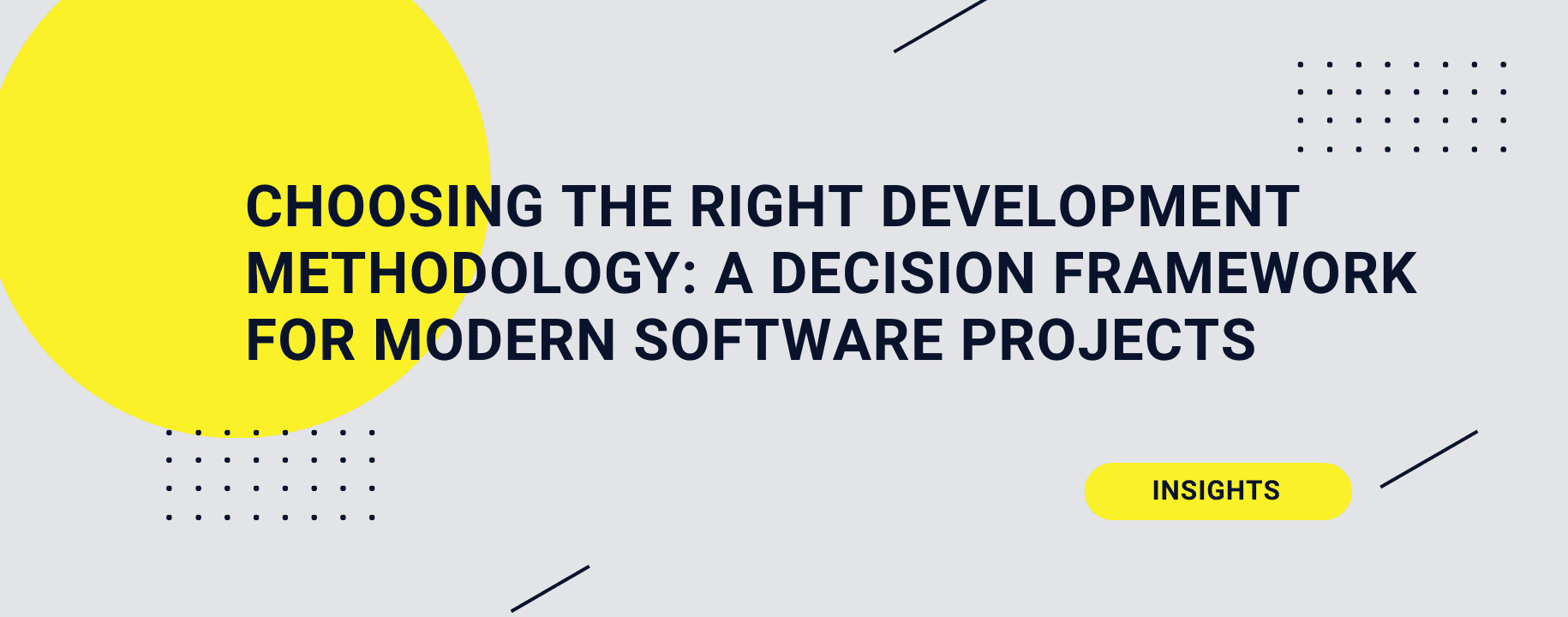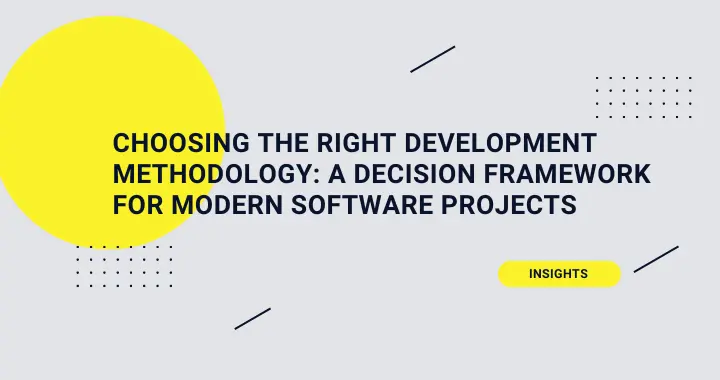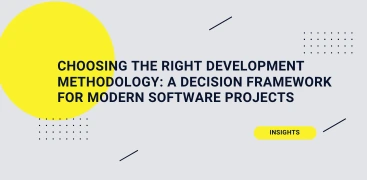- Industry insights
- 11 Feb 2025
Choosing the Right Development Methodology: A Decision Framework for Modern Software Projects
Where there's a software development team, there must be a clear plan! But which methodology works best? Discover a smart decision framework to guide your choice!



Table of contents
- Introduction: Understanding Complexity and Impact in Software Projects
- What is Software Development Methodology?
- What are Development Frameworks?
- Popular Software Development Methodologies: Agile vs. Waterfall
- Software Development Frameworks: Scrum vs. Kanban
- How to Choose the Right Software Development Methodology: 4 Key Factors
- Case Studies: Traditional vs. Modern Software Development Approaches
- Conclusion
Contributors

Introduction: Understanding Complexity and Impact in Software Projects
Where there’s a software development team, there must be a plan and a well-defined strategy to guide the members through every step of the process. Choosing a software development methodology is a complex decision, as it entails significant consequences related to the project’s success, team morale, and business outcomes.
The right choice will make it easier for the team to communicate and work well together. Enhanced productivity will help maintain high morale, and a motivated team will always deliver outstanding results, that will be reflected further in the business.
Read our article now and find out which software methodology best suits your case!
What is Software Development Methodology?
A software development methodology is the blueprint that guides the process of creating software, setting out the steps, the order, and how the team works together. The most popular methodologies, and the ones we will talk about in this article, are Agile and Waterfall.
What are Development Frameworks?
A development framework is a set of predefined tools and solutions that help the team develop software faster and easier. The most commonly used frameworks and the ones we’re going to discuss today are Scrum and Kanban.
In essence: Methodology is the overall plan of the development process (how to approach the project), and framework is the set of tools and solutions that help the team to implement this plan easier and faster.
Popular Software Development Methodologies: Agile vs. Waterfall
Before you choose your methodology, you need to ask yourself whether the most suitable way of working for your context is clearly structured or rather semi-structured. Let’s see how these two approaches divide into specific methodologies:
Agile Methodology
Agile is a flexible, semi-structured methodology that emphasizes constant collaboration between teams and the client, as well as rapid adaptation to change during the development of a project.
Instead of doing the whole project at once, you break it down into small steps, called sprints, each usually lasting 2-4 weeks. At the end of each sprint, delivering a small working product helps you get quick feedback from the client. If something goes wrong, you can quickly change direction.
Waterfall Methodology
Waterfall is a well-structured and sequential methodology. Each stage of the project has to be completed before the next one can begin, and there is little room for change along the way. It’s a linear process: you plan everything at the beginning (requirements, design, development, testing). Then, you implement all these steps one by one. In the end, you launch the full product.
Comparative Table Between Agile and Waterfall
| Aspect | Agile | Waterfall |
| Approach | flexible, continuous feedback | linear, sequential, fixed phases |
| Flexibility | high, changes can be made during the process | low, changes are difficult once phases start |
| Project Scope | can evolve based on ongoing feedback | defined at the start and stays the same |
| Client Involvement | continuous throughout the project | at the beginning and end |
| Delivery | incremental, frequent deliveries | one-time delivery at the end |
| Risk | lower risk due to frequent reviews | higher risk, as issues may be found later |
| Team Collaboration | strong, frequent meetings | less collaboration, more siloed teams |
| Project Complexity | complex, evolving projects with frequent changes | well-defined, simple projects with clear goals |
Software Development Frameworks: Scrum vs. Kanban
The following frameworks we will discuss are used in the Agile methodology. For Waterfall, there is no specific framework, as the methodology itself is already very well structured, following a series of clearly established steps: planning, design, development, testing, implementation, and maintenance. Agile methodologies, on the other hand, use frameworks such as Scrum or Kanban to organize and improve processes.
Scrum Framework
Scrum is a framework used in Agile to help teams collaborate efficiently. The Scrum Team has several roles, including Scrum Master (who helps the team get the job done), Product Owner (who represents the client’s interests), and Development Team (who does the actual work).
In each sprint, they set clear goals and try to deliver a working product at the end. Also, there are daily meetings (called stand-up meetings) where each member tells what they have done, what they are going to do, and where they have encountered difficulties.
Kanban Framework
Kanban is another Agile framework, but less structured than Scrum. It involves creating a Kanban board with columns (like a table), where tasks are divided into 3 main columns – To Do, In Progress, and Done. The team moves tasks from one column to another as they complete them. The Testing column can also be added if the process requires it.
Comparative Table Between Scrum and Kanban
| Aspect | Scrum | Kanban |
| Work Planning | work is planned in sprints | work is pulled as needed, continuous flow |
| Roles | defined roles (Scrum Master, Product Owner, Developers) | no mandatory roles, team self-manages |
| Meetings | daily stand-ups, sprint planning, retrospectives | meetings are optional, focus on workflow |
| Flexibility | limited changes during a sprint | highly flexible, changes can be made anytime |
| Team | teams needing structure and defined iterations | teams needing continuous delivery & flexibility |
Choose The Best of Both Worlds
You don’t have to strictly choose one methodology or framework, as both hybrid software development methodologies and a hybrid approach to framework usage can be considered.
For example, the team may follow an Agile approach using a Kanban board, while also adopting the stand-up meetings approach from Scrum. Alternatively, the team might use Waterfall for planning and initial requirements definition, then switch to Agile for actual implementation and development.
How to Choose the Right Software Development Methodology: 4 Key Factors
When you’re about to choose your software development methodology, consider these four key factors to make the best decision: project complexity, client involvement, team size, and organizational culture.
- Project complexity
This is the most important factor to keep in mind, and that’s because the level of complexity dictates how you work. Complex projects with constantly changing requirements, uncertainties, or multiple interconnected parts are better suited for Agile, which allows adaptability and flexibility. Simple projects, with clear and defined requirements from the start, are better suited to Waterfall, which follows a linear and detailed plan.
pitfall to avoid: choosing a methodology without considering the complexity of the project can lead to delays and adaptability problems.
- Client involvement
If the project requires continuous feedback and constant involvement from the client, Agile is more suitable. If the client is only involved at the beginning, Waterfall may be a better choice.
pitfall to avoid: not discussing the chosen methodology with the client in advance can lead to misunderstandings about the client’s expectations and involvement during the project.
- Team size
In small teams, you can communicate effectively and work more flexibly, making them better suited for an Agile methodology. In large teams with complex hierarchical structures, Waterfall can be more manageable due to its clear steps and processes.
pitfall to avoid: choosing a methodology based on team size alone, without considering other factors, can lead to difficulties. If you are in the middle ground, don’t forget to explore hybrid methodology options that can combine the advantages of both approaches.
- Organizational culture
Waterfall is suitable for organizations with a traditional culture, accustomed to structured processes and detailed planning. Agile, on the other hand, is best suited for organizations that encourage team autonomy and rapid communication between members.
pitfall to avoid: if your team is used to working freely and communicating quickly, Waterfall might seem too strict. Keep in mind the dynamics and working style of your teams.
| Choose Agile if… | Choose Waterfall if… |
| Requirements are likely to change frequently | Requirements are well-defined and stable |
| Continuous client feedback is needed | Frequent feedback or changes aren’t necessary |
| You want iterative and incremental work | You prefer a complete final delivery at the end |
| The team is small or medium and can collaborate closely | The team is big and works best in clearly structured phases |
| Quick delivery of functional parts is prioritized | The project can be delivered in one final phase |
| Flexibility and continuous improvement are very important | The project follows a fixed, unchanging plan |
| You need a high level of collaboration and team autonomy | The project requires more formal planning, control, and monitoring |
| The project is highly complex, with evolving requirements or unknowns | The project is less complex with well-understood requirements and a defined scope |
Case Studies: Traditional vs. Modern Software Development Approaches
NASA used the Waterfall Model to develop the software for the Space Shuttle program. This model provided a clear and structured process where each step was completed and reviewed before moving on to the next. NASA has used a very structured and disciplined approach for its projects, and the Waterfall model was preferred because of the need to ensure the safety and reliability of software in a critical context such as space missions.
Waterfall is a traditional software development methodology, while Agile is part of modern approaches. More and more companies are opting for Agile methods due to their flexibility and adaptability. Here are some examples of companies that have embraced the Agile methodology:
- Boeing: Integrated Agile and Scrum, leading to more effective project management and higher quality products.
- IBM: Embraced Agile and Scrum, resulting in faster development and better collaboration between teams.
- Microsoft: Switched to Agile and Scrum, leading to faster product launches and faster integration of customer feedback.
Conclusion
To sum up, the choice of software development methodology depends on several factors, such as the complexity of the project, the size of the team, or the involvement of the client. It’s important to consider each aspect before making a decision, and don’t shy away from using hybrid methods when needed. Each methodology has specific advantages, so adapting to the project’s needs is your key to success.
Find out more about the software project life cycle and development models in our article here.
Outsourcing vs. In-house Development: Why Romania is the Best Middle Ground
The Talent Pool in Romania: Why Global Companies Hire Developers Here
The Real Cost of Software Outsourcing: Why Romania Offers the Best ROI